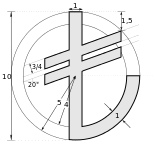Turkish lira sign

The Turkish lira sign (symbol: ₺; image: ![]() ) is the currency symbol used for the Turkish lira, the official currency of Turkey and Northern Cyprus. The design was presented to the public on March 1, 2012. The international three-letter code (according to ISO 4217) is TRY.
) is the currency symbol used for the Turkish lira, the official currency of Turkey and Northern Cyprus. The design was presented to the public on March 1, 2012. The international three-letter code (according to ISO 4217) is TRY.
In May 2012, Unicode decided the encoding of U+20BA ₺ TURKISH LIRA SIGN (HTML ₺) and it was included in Unicode 6.2 released in September 2012. It was the only character addition in version 6.2.[1] On Microsoft Windows operating systems, when using Turkish-Q or Turkish-F keyboard layouts, it can be typed with the combination AltGr+T.
Design
In order to improve the recognizability of the Turkish currency and to show its strength in a broad manner, it was decided to create a new symbol. For this purpose, a design contest was organized on September 8, 2011 by the Central Bank of Turkey.[4]
The design created by Tülay Lale was endorsed after a country-wide competition. It was chosen as the winner from a shortlist of seven submissions to the board of the Central Bank, selected from a total of 8,362 entries. The symbol resembles the first letter of the Turkish monetary unit L in the form of a half anchor with double stroke. With reference to "safe haven" notion in finance, the anchor depicts strength and confidence, and the upward-inclined double bar the steadily rising value of the currency and the Turkish economy.[5][6][7][8][9]
The Turkish lira sign was unveiled on March 1, 2012 in a presentation held in the Central Bank's main building by Prime Minister Recep Tayyip Erdoğan, Deputy Prime Minister responsible for the Economy Ali Babacan and the governor of the Central Bank Erdem Başçı.[10]
Criticism
Faik Öztrak, vice chairman of the main opposition party CHP, alleged that the new sign resembles the initials 'TE' of the then-prime minister (now president) (Tayyip Erdoğan) in a reference to the tughra of Ottoman sultans.[11]
The new Turkish lira sign has been criticized for allegedly showing a similarity with an upside-down Armenian dram sign.[9][12] It also bears a resemblance with the hiragana form of mo ("も") and the katakana form of re ("レ").
References
- ↑ "Unicode 6.2.0". The Unicode Consortium. 2012-09-26.
- ↑ Design Limits of Turkish Lira Sign
- ↑
- ↑ "TL Simgesine İlişkin Basın Duyurusu" (in Turkish). Türkiye Cumhuriyet Merkez Bankası. 2012-02-29. Retrieved 2012-03-04.
- ↑ "TL Simgesi Açıklandı". TCMB Bülten, March 2012 (Vol. 25) (in Turkish). 2012-03-01. Retrieved 2012-03-01., page 6.
- ↑ "Başkan Başçı'nın TL Simge Yarışması Basın Toplantısında Yaptığı Konuşma" (in Turkish). Türkiye Cumhuriyet Merkez Bankası. Retrieved 2012-03-01.
- ↑ "Türk lirasının yeni simgesi açıklandı". Haber 7 (in Turkish). Retrieved 2012-03-04.
- ↑ "Brand new Turkish Lira sign revealed". Hürriyet Daily News. 2012-03-01. Retrieved 2012-03-04.
- 1 2 "Dünyada TL kullanımı 3'e katlandı, 'çıpa'lı simge 'güvenli liman' mesajı oldu". Hürriyet (in Turkish). 2012-03-02. Retrieved 2012-03-04.
- ↑ "Turkish Prime Minister Recep Tayyip Erdoğan said that "Our people and institutions quickly adopted to the new lira"". Habertürk (in Turkish). 2012-03-01. Retrieved 2012-03-04.
- ↑ "CHP'den, TL simgesi için ilginç iddia". Hürriyet (in Turkish). 2012-03-01. Retrieved 2012-03-04.
- ↑ "Paramızın artık haysiyeti var faizlerin daha da inmesi lazım". Hürriyet (in Turkish). 2012-03-02. Retrieved 2012-03-04.
External links
| Wikimedia Commons has media related to Turkish Lira. |
- Türkiye Cumhuriyet Merkez Bankası, Central Bank of the Republic of Turkey
- TL Simge Turkish lira sign page of the Central Bank of the Republic of Turkey website
